





Call me old-fashioned, but in the war of the weeds, I prefer hand-to-hand combat over chemical warfare. In my experience pulling up weeds by hand or trowel is not only more effective at getting rid of them for good, it also promotes healthier soil.
Weeding by hand is more work than spraying weeds with an herbicide (See Landscaping 101: Pros and Cons of Homemade Weed Killer). But it need not be as backbreaking or time-consuming as you think–so long as you have the right weapons in your arsenal.
Photography by Justine Hand for Gardenista.
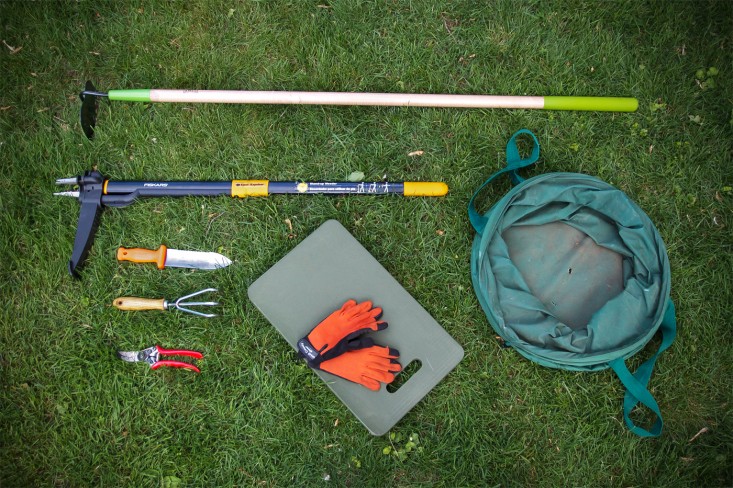 A Weeders Arsenal, by Justine Hand for Gardenista
A Weeders Arsenal, by Justine Hand for Gardenista
Above: My weeding arsenal includes the basics: a bag, gloves, knee pad, clippers, claw, and a hoe, as well as a few specialized tools: a soil knife, and a Fiskars UpRoot Weeder.
Every gardener has a favorite weeding tool. Kendra prefers Sneeboer’s Dandelion Digger; $45.75 (see World’s Best Digging Tools from Holland), while Michelle tackles her weeds with DeWitt’s F10 Hand Hoe; $45. Whichever feels most comfortable in your hand is a matter of personal preference. But in general, any weeding arsenal should include the following:
To these I would add one more back saver, a stand-up weeder.
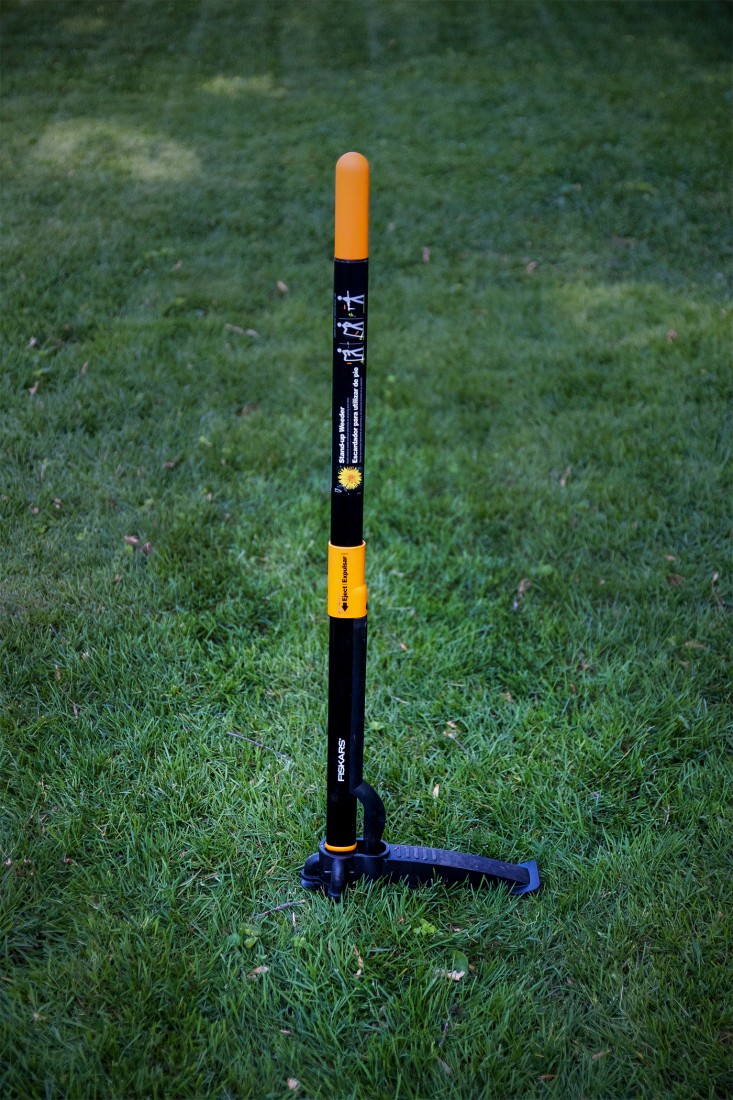 A Weeders Arsenal, Fiskars standup weeder, by Justine Hand for Gardenista
A Weeders Arsenal, Fiskars standup weeder, by Justine Hand for Gardenista
Above: My new favorite weeding tool: Fiskars UpRroot Weed Remover; $30 at Home Depot.
I admit, I bought Fiskars’ Uproot Weeder for my husband as a bit of a joke. You see, we have a running debate about weeds in our lawn. I, who grew up on the salty, grass-challenged soil of Cape Cod, view anything green as good. Chad, who put himself through college with his lawn care service, views anything less than a pristine grass as an affront to his (former) profession. (The kids, who like picking dandelion bouquets and later blowing the seeds off the heads, are on my side.) So when I saw an ad for this easy dandelion eradicator, I had to buy it for Chad. Call it one of those marital concessions you make when something is really important to your partner.
Long story short, it’s my new favorite tool. I’ve completely co-opted it for the garden.
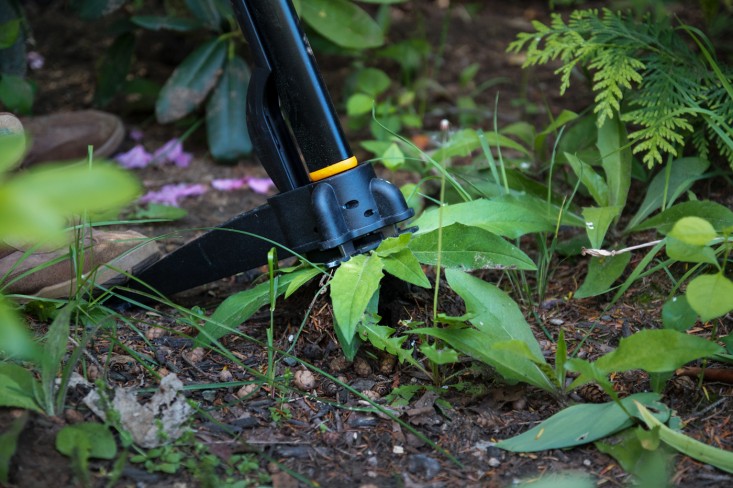 A Weeders Arsenal, Fiskars standup weeder detail, by Justine Hand for Gardenista
A Weeders Arsenal, Fiskars standup weeder detail, by Justine Hand for Gardenista
Above: My husband using the Fiskars Uproot Weed Remover.
All you do is center the teeth over the weed and shove into the soil. Then, stepping on the pedal, pull back until the weed comes free. To drop the weed, simply slide down on the release bar.
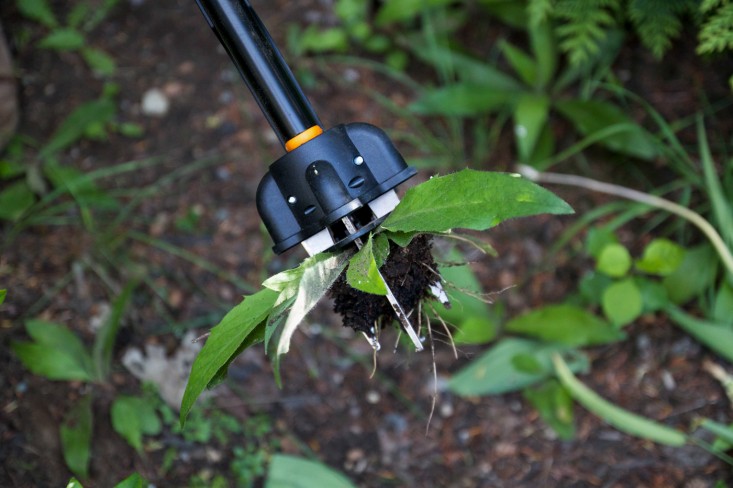 A Weeders Arsenal, Fiskars standup weeder detail 2, by Justine Hand for Gardenista
A Weeders Arsenal, Fiskars standup weeder detail 2, by Justine Hand for Gardenista
Above: The Fiskars UpRoot Weed Remover gets right to the roots.
I swear, this is not an infomercial, but at this point I do find myself wanting to say, “Wait, there’s more! The Fiskars UpRoot Weeder is so easy and fun, your kids will want to weed!!”
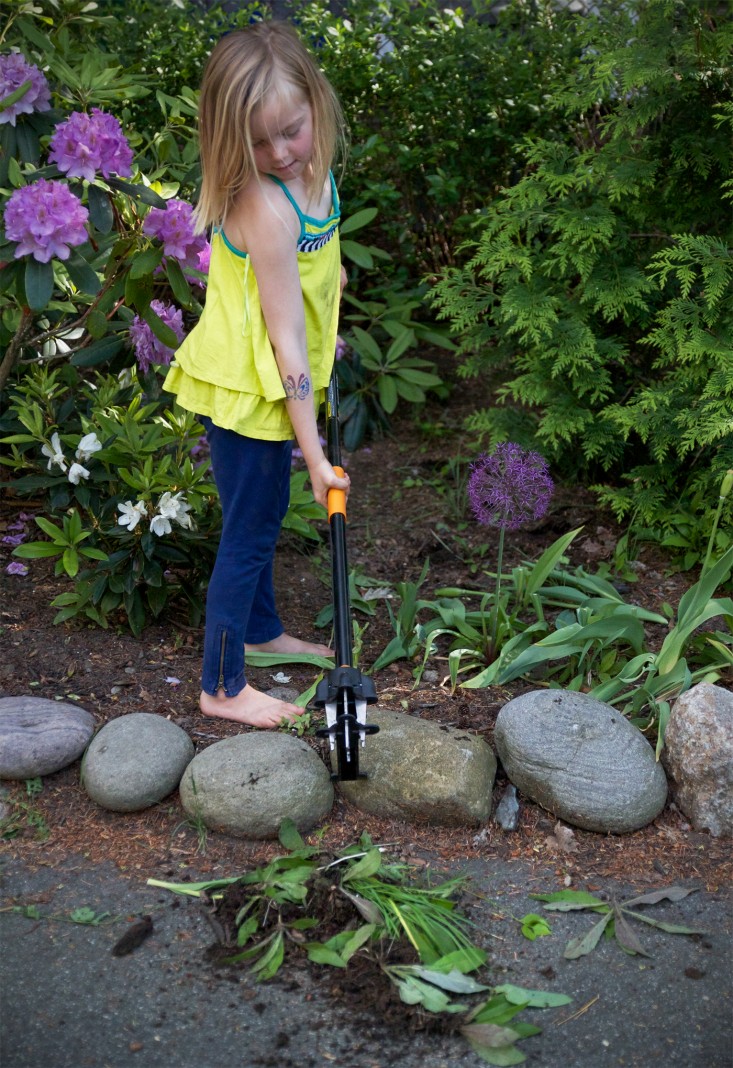 A Weeders Arsenal, may daughter Fiskars standup weeder, by Justine Hand for Gardenista
A Weeders Arsenal, may daughter Fiskars standup weeder, by Justine Hand for Gardenista
Above: Here’s Solvi making short work of some weeds with the uproot weeder. (Yes, I know she should have shoes on, but the tines are not sharp.)
Of course, as with every tool, stand-up weeders have some limitations. One Amazon reviewer complained that the Fiskars weeder left big holes in her lawn, but I don’t see how any weeder wouldn’t do that since, after all, you are digging something up. I guess she was comparing the results to chemical weed killer, but that would leave a dead spot. Anyway, I did not find the resulting holes to be too big.
What I did find is that since you can’t adjust the width of the teeth or tines, the uproot weeder doesn’t work for larger weeds, particularly big clumps of grass. It also isn’t useful for weeds with long, robust roots such as Virginia Creeper. At the other end of the spectrum, the Fiskars UpRoot Weed Remover is overkill for weeds with shallow roots. For these two types of offenders, I use my claw and soil knife.
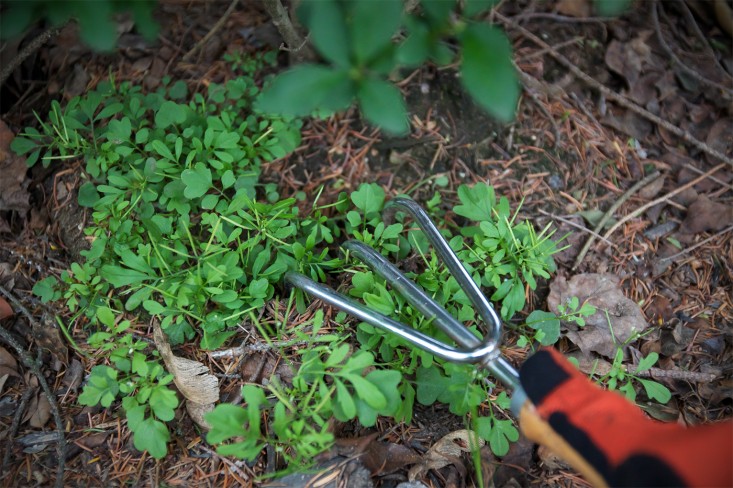 Gardenista, A Weeders Arseanl, claw tool, by Justine Hand
Gardenista, A Weeders Arseanl, claw tool, by Justine Hand
Above: The claw is useful in getting grid of “clumping” weeds with shallow root systems, particularly those tucked in hard-to-reach places, like the area under a hedge. (I just have a basic claw, but you can get a really nice hand-forged Three-Tined Garden Rake from Fisher Blacksmithing; $50. See The Claw: A Tool Weeds will Fear.)
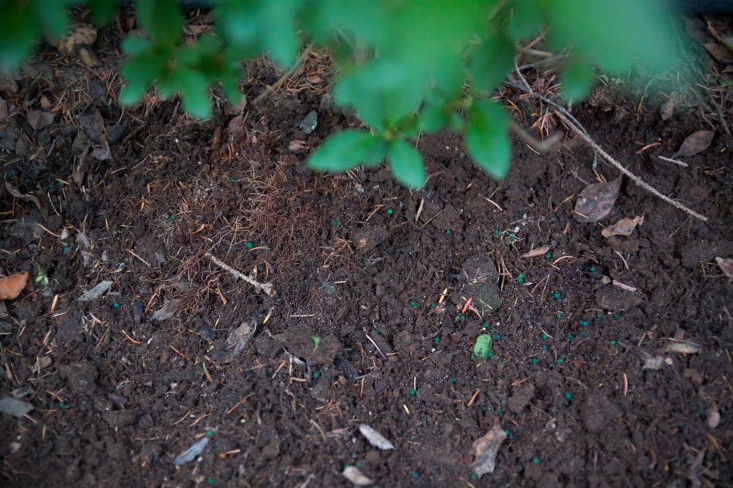 Gardenista, A Weeders Arsenal, results from claw, by Justine Hand
Gardenista, A Weeders Arsenal, results from claw, by Justine Hand
Above: It took me about a minute to clear this area with my claw.
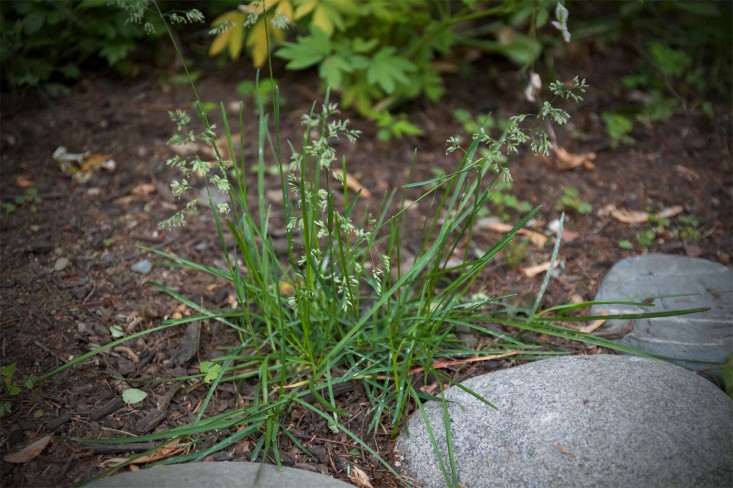 Gardenista, A Weeders Arsenal, clump of grass, by Justine Hand.
Gardenista, A Weeders Arsenal, clump of grass, by Justine Hand.
Above: Prime offender: grass, so welcome in my lawn, so unwelcome in my garden.
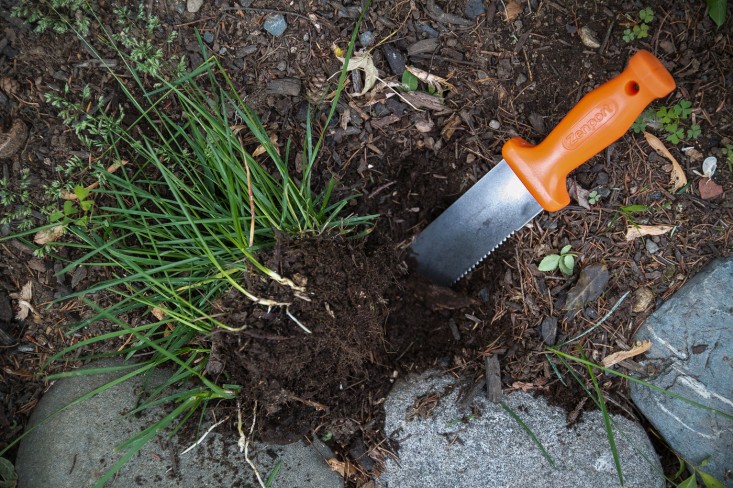 A Weeders Arsenal, hori hori knife, by Justine Hand for Gardenista
A Weeders Arsenal, hori hori knife, by Justine Hand for Gardenista
Above: With its long, sharp blade, my Zenport Zenbori Soil Knife (available at Amazon for $19) makes quick work of grass’ tenacious root system. Then I use this same versatile tool to dig a hole in any bare patch of lawn, where I then transplant the formerly offending grass. Voilí , recycling!
Also a favorite of Michelle (See My Most Useful Garden Tool: Hori Hori Knife), this knife is likewise my go-to for weeds with long, tenacious root systems such bittersweet and the dreaded Virginia creeper. (Honestly, these are the only enemies that make me think twice about my stance against chemical warfare.)
Finally, with its thin blade, a soil knife can work out weeds in very narrow spaces. In between the bricks of your patio, for example.
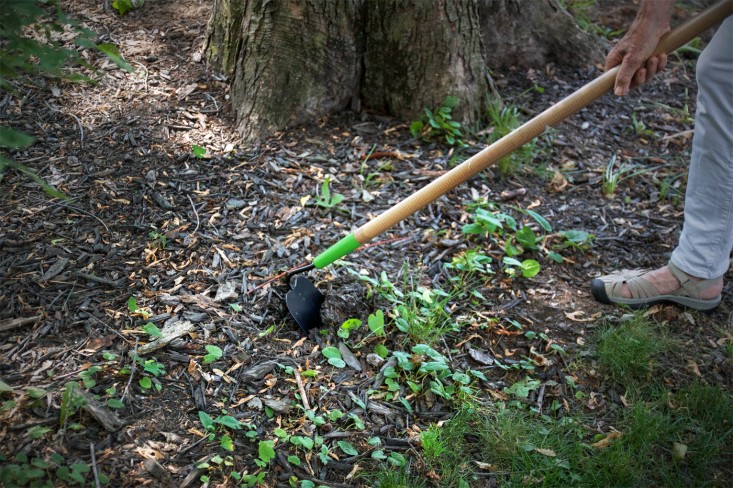 A Weeders Arsenal, hoe, by Justine Hand for Gardenista
A Weeders Arsenal, hoe, by Justine Hand for Gardenista
Above: My mother helps me clear a new bed, which is going to get a nice covering of shade-tolerant, groundcover.
Last but not least, there’s the tried and true hoe. Effective at quickly clearing large swaths of weeds with shallow roots, a hoe is particularly useful in the vegetable garden, or wherever there is a lot of room in between desirable plants. A hoe is also ideal if you want to mulch your weeds right back into the soil (not recommended if the weeds have seeds on them).
Remember that a hoe is more of a chopping tool than a digger or a rake. To use it, make quick, downward, shallow strokes to cut weeds at the soil line. Be careful not to dig too deep as disturbing the soil can actually encourage dormant weed seeds to grow. For this reason, be sure to apply mulch right after you hoe. (To learn more about no-dig gardening, see Charles Dowding’s No Dig (and No Weed) Garden in Somerset.)
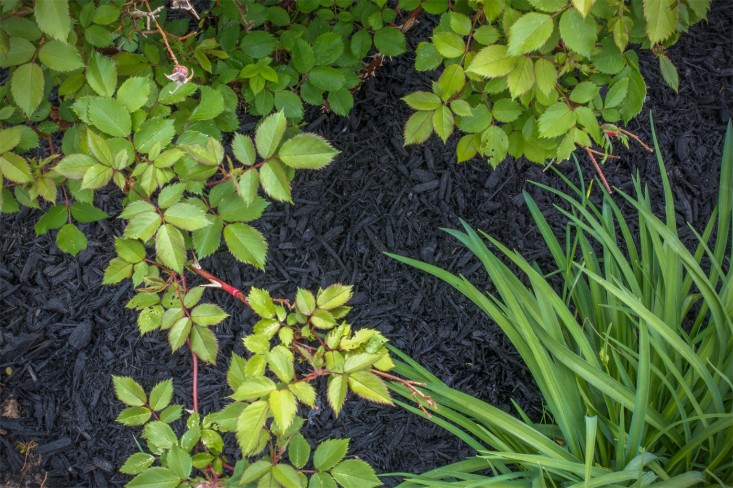 A Weeders Arsenal, mulch 2, by Justine Hand for Gardenista
A Weeders Arsenal, mulch 2, by Justine Hand for Gardenista
Above: After I’ve pulled, plucked, hacked, and scraped all the weeds from my garden, I apply the final tool in my weed killing arsenal: mulch. Weeds need sunlight to grow, so I smother them with a good two inches of bark mulch, all while enriching my soil. Also by providing a barrier between your soil and weed seeds, mulch helps to keep new weeds from germinating.
Still seem like a lot? Remember that the more thorough a job you do this year, the less you will have to do next.
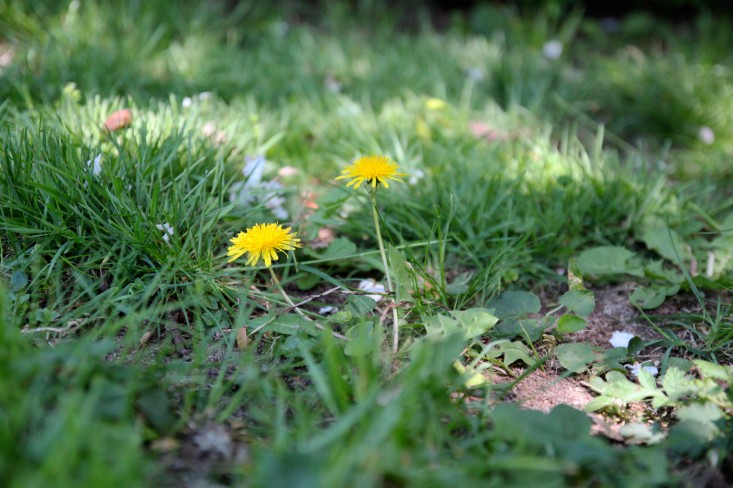 Gardenista, Out of the Weeds, Homemade weed killer
Gardenista, Out of the Weeds, Homemade weed killer
Michelle has also had some experience with weeds. See Why I Weed and Landscaping 101: How to Kill Poison Ivy. Also remember that not all weeds are bad. See In the Weeds: A Foraging Food Show and Lemon Balm: Weed or Wonder.
 gardenista-cda-article-banner-4
gardenista-cda-article-banner-4
Copyright © www.100flowers.win Botanic Garden All Rights Reserved